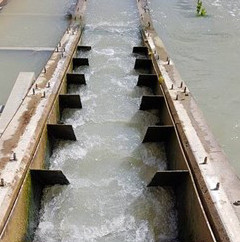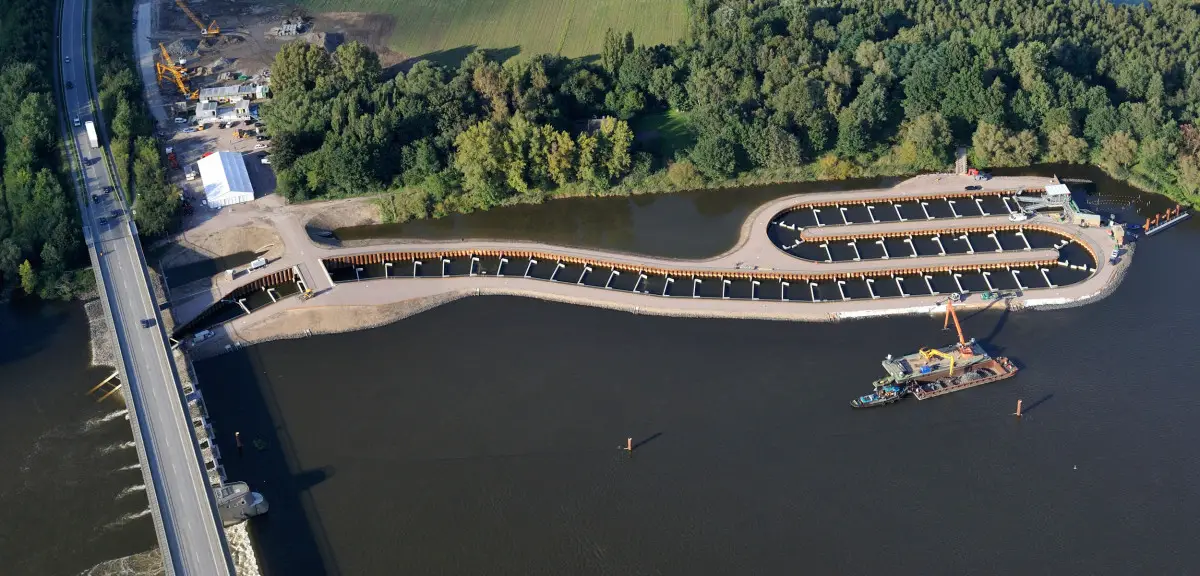In the United States, more than 2 million dams and other barriers block fish from migrating upstream to spawn as a result, many fish populations have declined. For example, Atlantic salmon used to be found in every river north of the Hudson River. Some manmade devices have helped like the fish ladder. What is a Fish Ladder?
Fish ladders found along fish migration routes are structures that are located in waterways, usually rivers, alongside manmade or natural obstructions like Dams, waterfalls, and locks that impede fish migration patterns, fish ladders are also known as fish steps, fish passes, or fishway.
Designs vary depending on the obstruction, river flow, and species of fish affected, but the general principle is the same for all fish ladders: the ladder contains a series of ascending pools that are reached by swimming against a stream of water. Fish leap through the cascade of rushing water, rest in a pool, and then repeat the process until they are out of the ladder.
What is a Fish Ladder and Its Significance in River Dams
So, what’s a fish ladder? Well, it’s a man-made structure that helps our fishy friends get around a dam. Dams, while good for us humans, can be quite a hindrance for our underwater pals. These structures built by clever humans can seriously mess up fish migration patterns on rivers.
That’s where a fish ladder or fishway, comes in handy. Fish ladders are pretty much just like what they sound like – ladders for fish! Now, how can a fish climb a ladder, you might ask? It’s not like they’ve got tiny little fish hands. But see, fish ladders aren’t ordinary ladders. They’re more like passageways, designed to help fish overcome man-made Dam obstacles along a river and continue their migration journey.
So, the next time you hear about a dam being built, picture a fish ladder constructed next to it. See, we’re not just dam builders; we’re also fish helpers. As sustainable-thinking people, we believe in living harmoniously with nature and helping our fish buddies out wherever we can.
The Function and Importance of Adult Fish Ladder Systems in River Dams
Alright mate, let’s talk about the whole mechanism and architecture of a fish ladder. You know, it ain’t just a plain ol’ ladder, it’s a carefully planned passage for our fishy mates, especially the adult ones, that helps them scoot around those pesky river dams. Think of it like steps in a pool, but individually designed like small, concrete rooms. It’s sort of its own fishing management system, takin’ care of species, like salmon, that we’re keen to protect.
A well-built fish ladder is like a series of pools, stacked up in a stepped fashion. Each pool mimics natural water conditions that fish, like salmon, need for migration and spawning. These species can jump from pool to pool, climbing up the ‘ladder’ one step at a time till they’re safely past the dam.
The construction and management of these concrete pathways require a good understanding of fish biology and river ecology to ensure successful passage for various species. So next time you’re out fishing, you’ll know what you are looking at.
The survival of many fish species depends on migrations up and down rivers. Among Anadromous fish such as salmon, shad, and sturgeon, downstream migration is a feature of early life stages, while upstream migration is a feature of adult life. Anadromous fishes are those that spawn in freshwater, migrate to the ocean to forage and mature, and return to freshwater to spawn and begin the cycle again.
Among Catadromous (migrating down rivers to the sea to spawn) like the North American eel, the opposite is true. River obstructions such as dams, culverts, and waterfalls have the potential to slow or stop fish migration. Indeed, these impediments to fish migration are often implicated in the decline of certain fish stocks.
How Water Systems and Fish Ladders Complement Each Other in River Ecosystems

It’s time for a look into how water systems and fish ladders meet for the well-being of our river ecosystems. Just picture this: your beloved Columbia River flowing free and fresh, teeming with life and man-made Dams. Fish ladders play an essential role, allowing the older fish to return to their spawning grounds and keep the population healthy. It’s like having an escalator in a dam.
They’re cleverly designed to mimic the water conditions that our fish friends prefer. They support such ecosystem restoration efforts, understanding the inseparability of healthy water systems and effective fish ladders.
A fish ladder, also known as a fishway, gives a detour route for migrating fish past a particular obstruction on the river. Designs vary according to the obstruction, river flow, and species of fish affected, but the general principle is the same for all fish ladders:
The ladder contains a series of ascending pools that are reached by swimming against a stream of water. Fish leap through the cascade of rushing water, rest in a pool, and then repeat the exercise until they are out of the ladder.
So you see, fish ladders and the water they’re nestled in, have got to be fitted just right so they work perfect. The fish ladder, and water systems, is a man-made marvel that allows species of fish to move up and down the rivers and live uninterrupted while Dams protect the humans that live in the area around the river where they are built.
Key Role of Pool Structures in Fish Ladders for the Continuity of River Life
Fish ladders have a mixed record of effectiveness. They vary in effectiveness for different types of species, with one study showing that only three percent of American Shad make it through all the fish ladders on the way to their spawning destination.

They are fish ladders, dams, weirs, etc. A fish ladder is constructed to allow fish to pass over a dam by providing water velocity which a fish can negotiate while pushing upstream.
But when the flowing water passes over the steps of the ladder, the action is like a cascade aerator. Even small dams like weirs that are a meter tall can stop fish from swimming upstream because they are higher than most fish can jump.
Fish ladders, still are a major game-changer, especially when you’re talkin’ about keeping things smooth-like for our fish in the river. These clever contraptions play a key role in connecting the dots between pools, reservoirs, and open waters. Above all, is the clever pool structures in these fish ladders, ain’t nothin’ like a good ol’ pool to help our finned friends make the leap.
These fish ladders even have a social side too. They ensure all species, from tough salmon to tiny minnows, can navigate around hydropower dams and keep the river life rockin’. Ever tried fishing in a spot where no salmon have ventured ’cause they got stumped by a river hurdle?
With fish ladders, structures ensure the continuity of the ebb and flow in the river channel. Here at MyWaterEarth&Sky, fish ladders and mighty reservoirs are a part of the incredible tangle of life beneath the water.
Types of Fish Ladders: Adapting to the River Environment and Fish Needs
Got some curiosity brewing about fish ladders, eh? Well, mate, let me tell you, they’re top-notch for our fishy friends. Helping our scaly buddies tackle the mighty river and dam obstacles just wouldn’t be possible without these aquatic stairways.

They’re also a beauty for those joinin’ the fisheries. Imagine a highway, but underwater, and strictly for fish. Yeah, that’s a fish ladder, and there are various models, adapting to the river environment and the many needs that different fish species have.
You see, the thing about fish ladders, or fishways if you like to get technical, is that they’re delicately designed with pools. These setups make it easier for the fish to rest and regain their strength as they make their way upstream. That makes the whole Dam problem and what to do with them less of an issue, allowing the flow of adult spawning fish in rivers to be maintained.
Here at MyWaterEarth&Sky, we love seeing fishways in action. They’re great for the fish, and they’re great for us in the fisheries business. They really guide the fish, helping us all out! So cheers to fish ladders, the true example of sustainable engineered structures for American rivers!
Compared to ladder-type fish passes, the fish elevator facilitates a huge amount of fish migration at a given time. Some large-sized species may not travel upstream in ladder-type passes due to the small size of openings, and poor swimming capabilities. For such types of species, Fish elevators work best.
There are more than 80,000 dams in the U.S. and nearly all of them have some kind of fish pass. They range from multi-step ladders like the Seattle one to elevators that suck the fish upstream to nature-like diversion canals
To help fish surmount the looming wall of a dam and reach upstream waters, dams are fitted with stairlike structures called ladders (fish leap up a series of pools) and elevator-like contraptions called lifts (fish are channeled into a hopper that gets raised)
Different types of Fish ladders are as follows :
- Pool and Weir fish ladder
- Pool and Orifice fish ladder
- Vertical slot fish ladder
- Baffle fishway
- Rock ramp
- Fish elevator
- Siphon fish
Conclusion:
A fish ladder, also known as a fishway, gives a detour route for migrating fish past a particular obstruction on the river. Designs vary according to the obstruction, river flow, and species of fish affected, but the general principle is the same for all fish ladders; the Fish ladder in a river contains a series of ascending pools that are reached by swimming against a stream of water. Fish leap through the cascade of rushing water, rest in a pool, and then repeat the exercise until they are out of the ladder.

References:
National Oceanic and Atmospheric Administration (NOAA) What is a Fish Ladder
Science Direct-Anadromous Fish
FAQ’S
Q: What are fish ladders?
A: Fish ladders aren’t ordinary ladders. They’re more like passageways, designed to help fish overcome dam obstacles and continue their migration journey. They’re vital for maintaining the steady flow of fish populations, especially adult fish.
Q: How do fish ladders work?
A: A well-built fish ladder is like a series of pools, stacked up in a stepped fashion. Each pool mimics natural water conditions that fish, like salmon, need for migration and spawning. These species can jump from pool to pool, climbing up the ‘ladder’ one step at a time till they’re safely past the dam.
Q: Why are fish ladders important?
A: Fish ladders are essential as they ensure the healthy flow of fish, especially adult fish, which is crucial for sustainable fisheries. They literally support the lifeline of rivers by ensuring uninterrupted fish migration. They also play an essential role in allowing the older fish to return to their spawning grounds and keep the population healthy.
Q: What are adult fish ladders?
A: Adult fish ladders are specially designed diversions aimed to help mature fish overcome human-made barriers, like dams, in their journey upstream. They’re a part of our national ecosystem restoration efforts, and help in efficient river management.
Q: How do fish ladders help in ecosystem restoration?
A: Fish ladders play a vital role in the restoration of our ecosystem. The health of the river and its entire ecosystem relies a lot on fish migrations. Dams, while beneficial for humans, can severely disrupt these crucial migration patterns. Fish ladders provide an effective solution, allowing fish to continue their upstream journey in spite of these barriers. They contribute greatly to maintaining the ecological balance of our water systems.

